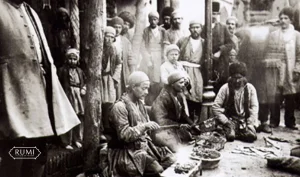KABAB KOBIDE
In this article, we aim to introduce the history of kabab kobideh. Kabab kobideh is a type of kebab made primarily from ground meat.This dish is usually served with rice and is one of the most popular kababs among Iranians. The secret to its deliciousness lies in the high-quality ingredients and the skill involved in its preparation.
HISTORY_OF_KABAB KOBIDE
The history of kabab kobide dates back thousands of years and is recognized as one of the most popular and beloved foods worldwide.
The_earliest historical records of using fire and cooking food date back to approximately 120,000 years ago in the grand palaces of Iran, which included Shush, Susa, or Pasargadae. In these places, many kebabs were prepared. The_history of kababs dates back to ancient times. The earliest traces of cooking kababs are from the time of the Achaemenids, about 2500 years ago.
HISTORY OF KABAB KOBIDE
The_oldest Chelokababi (restaurant specializing in kababs and rice) established in Tehran dates back to approximately 120 years ago
E’temad al-Saltaneh mentions in his writings that the first cholo-kabab restaurant was called Nayeb and was located in Tehran’s bazaar, serving food in a manner similar to European restaurants. However, there are also other documents indicating that the first cholo-kabab restaurant was established in Tabriz, near the Caucasus border. At Nayeb, waiters arranged rice in pyramids on the plates and served a piece of butter alongside. They brought the rice to the tables one by one, while the next waiter immediately placed the kebabs on the plates.
One of the most famous cholo-kabab restaurants in Tehran was Cholo Kabab Shamsiri, founded during Reza Shah’s era and located in the eastern part of Sabzeh Meydan. This restaurant has always played a significant role in the history of kabab kobideh. Later, it was moved to a four-story building, where the first floor was the kitchen, the second was for merchants and single patrons, and the third and fourth floors were designated for families and dignitaries. Each floor was decorated with many mirrors, and Mr. Mashiri personally oversaw the upper floors.
Starting from 11 a.m., the aroma of kabab and rice being cooked at Shamsiri filled the surrounding area, enticing passersby to try this incredible dish. The cholo-kabab served at Shamsiri consisted of a plate of rice with butter and two kababs.
E’temad al-Saltaneh, the Minister of Publications during the reign of Nasir al-Din Shah and head of the translation office at that time, stated that he paid between 3 and 5 rial for the best kabab served at Nayeb.
In 1916, Abdullah_Bahrami, the deputy head of Tehran’s security department (the modern police). Reported that he paid the highest amount of 4 to 5 rial for each portion of cholo-kabab. About thirty years ago, in 1320,the newspaper Etela’at charged 5 rial for a serving of cholo-kebab. Which included a large kebab, 330 grams of butter, rice, onion, and bread. At the same time, kabab kobideh cost 4 rial.
Between the years 1330-35, a kabab kobideh cost 3.5 rial in Tehran, while in other cities, two kababs with bread and grilled tomatoes, forming a complete serving, cost 8 rial. If lemonade or soda was also consumed, an additional 2 to 4 rial was charged. Thus, with 10 to 12 rial, a person could have a complete meal.
During that time, kabab juice was used to enhance the flavor of the kababs, and the scent of this juice dripped onto the coals, making many customers hungry. In 1352, cholo-kabab with butter, grilled tomatoes, onions, and sumac cost 60 rial, and many people who worked and could not go home often ate cholo-kabab. Students with better incomes typically ordered chicken kabab, which cost 120 rial.
At that time, there was a very large bowl in kabab restaurants where they made doogh (a yogurt drink) that was served with the food. Other documents also show the influence of the first kebab restaurant in Tabriz.
The first kabab restaurant in Tehran, where women could also be present, was Abbas Shamerouni (later known as Fard Shamirani), located in Amin al-Soltan Square (near the old gate of Abd al-Azim).
Reason for the Name Kabab Kobide
In examining the history of kabab kobideh, it has become clear that at that time, there were no meat grinders. Therefore, the meat was softened and prepared for skewering by pounding and chopping it. As a result, this kabab became known as kobideh.
Sumac is sprinkled over kabab kobideh as a seasoning, and its tangy flavor enhances the deliciousness of the dish. It is served alongside fresh herbs, onions, and pickles.










